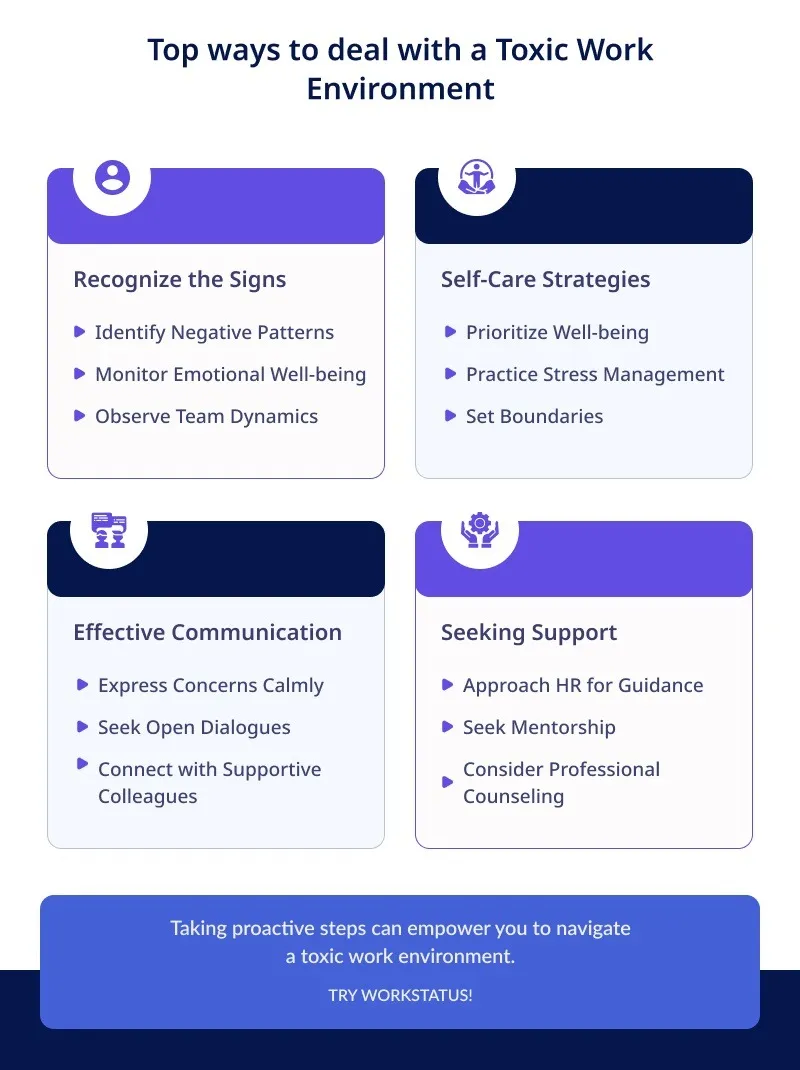Table of Contents
Introduction
A toxic work atmosphere adversely affects employees’ physical and psychological well-being, as emphasized by the U.S. Surgeon General and the WHO.
Moreover, it threatens your organization’s health by undermining staff efficiency and causing a high attrition rate.
Unfortunately, a toxic work environment is a prevalent issue.
In a study by the American Psychological Association, 18 percent of employees reported being subjected to a somewhat or highly toxic workplace, with 30 percent having encountered instances of the following at the workplace:
- Mistreatment
- Aggression
- Harassment
Regrettably, toxic workplace conditions are frequently rooted in organizational culture, often from higher management.
The repercussions reverberate throughout the organization when leaders exhibit negativity or mistreat employees.
This highlights the significance of remaining vigilant for indicators of a toxic work environment and proactively addressing them to prevent extensive harm.
Signs of a Toxic Work Environment
Here are some signs of a toxic work environment:
Low employee morale
Within toxic work environments, employees often experience a sense of deflation and discouragement, leading to reduced enthusiasm and motivation to engage.
Research indicates that negativity can be infectious, contributing to elevated turnover rates and decreased productivity.
Fear of failure
Toxic work environments lack the presence of psychological security.
It makes employees fearful of potential negative repercussions when expressing thoughts, sharing ideas, taking risks, or making mistakes.
Consequently, a culture of assigning blame and pointing fingers flourishes instead of fostering a culture of accountability.
Notably, Google’s research highlights that psychological safety significantly influences team effectiveness, outweighing factors like structure, significance, and reliability.
Cutthroat competition
While fostering healthy competition benefits businesses, a culture that promotes undermining one another for personal gain can foster resentment and undermine overall productivity.
Instead of efficient inter-team collaboration, employees within a toxic work setting may engage in blaming or even sabotaging each other.
Lack of recognition or growth
Employees require recognition and growth prospects.
While competitive compensation and comprehensive benefits lay a foundation, employees also seek assurance that their contributions are valued and acknowledged.
In toxic workplaces, employees are often left to devise their career paths independently, lacking guidance or chances for mentorship and internal advancement.
This deficiency can end the motivation of even the most dedicated team members.
Ready to drive results?
Achieve peak performance and success.
Unethical or Disrespectful behavior
Experiencing disrespect at the workplace serves as a strong predictor of employees’ perception of their company’s culture.
Workers also identify unethical conduct, including falsehoods, deception, broken promises, and non-compliance with regulations, as indicative of a toxic work environment.
Effects of a Toxic Work Culture
Burnout and poor mental health
A toxic work culture results in employee burnout, where employees experience chronic stress, exhaustion, and emotional detachment.
This detrimentally impacts their mental well-being, causing anxiety, depression, and decreased overall quality of life.
Workstatus understands the critical importance of employee well-being.
Here’s how Workstatus can help:
Stress Level Insights: Workstatus provides stress level insights based on task completion patterns. It helps employees and managers identify excessive workloads and encourages a healthier distribution of tasks, reducing the risk of burnout.
Wellness Reminders: Workstatus includes customizable wellness reminders that prompt employees to take breaks for self-care and better mental well-being.
Broadcast Messages: Effective communication within Workstatus lets team members discuss task distribution and share the burden during challenging periods, fostering a supportive environment that alleviates stress.
Higher health care costs
A toxic environment’s toll on employees’ health can increase healthcare costs for individuals and the organization.
Stress-related illnesses and psychological concerns contribute to elevated medical expenses.
High employee turnover
Constant exposure to toxicity prompts employees to seek healthier work environments, leading to high turnover rates.
It disrupts team dynamics, burdens remaining staff, and entails significant recruitment and training costs.
At Workstatus, we recognize that retaining talent is vital.
Here’s how Workstatus can help:
Task Transparency: Get clear task visibility, showing each team member’s contributions. It boosts employee morale, recognition, and job satisfaction, reducing the likelihood of turnover.
Performance Reports: The platform generates detailed performance reports, aiding managers in recognizing and acknowledging exceptional efforts. A positive feedback loop can enhance retention by making employees feel valued.
Reduced productivity
Toxic cultures sap motivation and enthusiasm, leading to reduced productivity.
Negative interpersonal dynamics and demotivation hinder task completion, affecting project timelines and efficiency.
Workstatus is your productivity partner.
Here’s how Workstatus can help:
Task Tracking: Track task completion rates and efficiency, helping employees prioritize work and allocate time effectively, counteracting the negative impact of reduced motivation.
Time Management Tools: Workstatus enables employees to set focused work intervals, maintain a healthy work-life balance, and mitigate productivity loss in a toxic environment.
Task Analytics: Task analytics lets managers pinpoint bottlenecks, optimize workflows, and provide targeted support to teams struggling with reduced productivity due to toxic work culture.
Difficulty attracting top talent
Word spreads fast, and a toxic reputation can deter top-tier talent from joining the organization.
Prospective employees prioritize a positive work environment, making talent acquisition a challenging endeavor.
More cases of absenteeism
Toxicity’s toll on well-being leads to increased absenteeism.
Employees take time off to cope with stress and illnesses or escape the unhealthy atmosphere.
Employee well-being is a cornerstone of Workstatus.
Here’s how Workstatus can help:
Read More: 8 Tips to Reduce Employee Absenteeism
Flexible Work Arrangements: Workstatus supports remote work and flexible hours, letting employees adapt their schedules to manage their well-being and work environment better, potentially minimizing absenteeism.
Task Transparency: Transparent task assignments ensure everyone is aware of their responsibilities. It reduces workload, contributing to a healthier work environment and fewer instances of absenteeism.
Poor business performance
A toxic work culture ripples the organization, impacting decision-making, collaboration, and innovation.
It ultimately hampers business performance and growth.
Elevate your business with Workstatus.
Here’s how Workstatus can help:
Data-Driven Insights: Get insights into task completion rates, efficiency, and collaboration patterns. These insights empower managers to make informed decisions that can lead to improved business performance.
Performance Analytics: Performance analytics enable you to track progress, identify areas of improvement, and implement data-driven strategies to boost productivity despite the challenges of a toxic environment.
Lack of team cohesion
Negative interpersonal interactions erode trust and camaraderie among team members.
A lack of cohesion hinders effective collaboration, stifling creativity and hindering collective progress.
Dealing with a Toxic Work Environment
Read the below infographics to learn about the ways to deal with a toxic work environment:

Creating a Positive Work Environment
Here are some of the great ways to create a positive work environment:
- Open Communication: Foster a culture of transparent and respectful communication. Encourage sharing ideas, concerns, and feedback openly, creating an atmosphere of trust and collaboration.
- Recognition and Appreciation: Regularly acknowledge and appreciate employees’ contributions. Celebrate big and small achievements to boost morale and reinforce a sense of value.
- Work-Life Balance: Support employees in achieving a healthy work-life balance. To promote well-being, offer flexible schedules, remote work options, and wellness programs.
- Professional Development: Provide opportunities for skill enhancement, growth, and career advancement. Investing in employees’ growth shows commitment to their success and enhances their motivation and engagement.
Closing Thoughts
In IT, navigating a toxic work environment is no small feat.
By recognizing the signs and implementing strategies for resilience, you have taken a proactive step toward your well-being.
Remember, your journey doesn’t end here – armed with insights, you’re equipped to survive and thrive against all odds, reshaping your IT experience for the better.











